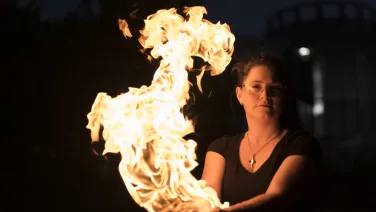Viewing the climate through a veil of broken glass
When scientists at the ANU Institute of Climate, Energy and Disaster Solutions take a closer look at planet Earth – one of their favourite tools to use is data. But not ANU Honorary Lecturer Ngaio Fitzpatrick.
“I’m an artist and a bit of a vandal,” she says.
When it comes to understanding how different climate and biological systems impact our world, Ngaio’s tool of choice is glass. Or more specifically waste industrial glass that is shattered into tiny fragments and then reformed into spectacular coral structures.
“Glass is an amazing material. To me, waste glass is something that is fragile, dangerous yet easy to break. This speaks so much to our relationship with the environment.”
Ngaio’s art practice isn’t only about creating beautiful objects at the Canberra Glassworks. She also wants to help you navigate the complex human emotions surrounding the changing climate.
“Back in 2013, so many pieces of the picture slotted together for me,” she says. “The fact that we’re on this runaway train, and we don’t know enough about how biosystems interconnect with each other to understand how changing one thing could have a bigger and unforeseen impact down the chain.
“I felt that I could explore these ideas through visual art.”
Ngaio Fitzpatrick started working in partnership with the ANU Institute for Climate, Energy & Disaster Solutions as a recipient of an ANU Vice Chancellors Artists Fellowship in 2016. Since then she has held a requiem for a reef and represented mass extinctions by shattering 50-kilogram sheets of glass in front of a captivated audience to create immersive environments.
“I feel strongly that my practice isn’t about data, but the human emotions surrounding the relationship between us and the changing climate.
“Scientists and science have the data and the facts, but they cannot use emotion to describe the predicament we find ourselves in, whereas artists can.”
The school theme for National Science Week this year is Glass: More than meets the eye. If you are burning to know more about the science of glass check out the inner working of glass making event at the Canberra Glassworks.



